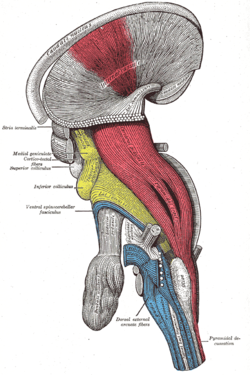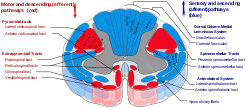Thepyramidal tractsinclude both thecorticobulbar tractand thecorticospinal tract.These are aggregations ofefferent nerve fibersfrom theupper motor neuronsthat travel from thecerebral cortexand terminate either in thebrainstem(corticobulbar) orspinal cord(corticospinal) and are involved in the control of motor functions of the body.
| Pyramidal tracts | |
|---|---|
 Deep dissection of brain-stem. Lateral view. ( "pyramidal tract" visible in red, and "pyramidal decussation" labeled at lower right.) | |
 Spinal cord tracts,withpyramidal tractslabeled at upper left | |
| Details | |
| Decussation | Many fibres in pyramids ofmedulla oblongata |
| From | Cerebral cortex |
| To | Spinal cord(corticospinal) orbrainstem(corticobulbar) |
| Identifiers | |
| Latin | tractus pyramidalis tractus corticospinalis |
| MeSH | D011712 |
| NeuroNames | 1320 |
| NeuroLexID | birnlex_1464 |
| TA98 | A14.1.04.102 A14.1.06.102 |
| TA2 | 6040 |
| FMA | 72634 |
| Anatomical terms of neuroanatomy | |
The corticobulbar tract conductsimpulsesfrom thebrainto thecranial nerves.[1]These nerves control the muscles of the face and neck and are involved in facial expression, mastication, swallowing, and other motor functions.
Thecorticospinal tractconducts impulses from the brain to the spinal cord. It is made up of alateralandanterior tract.The corticospinal tract is involved in voluntary movement. The majority of fibres of the corticospinal tractcross overin themedulla oblongata,resulting in muscles being controlled by the opposite side of the brain. The corticospinal tract contains theaxonsof the pyramidal cells, the largest of which are theBetz cells,located in the cerebral cortex.
The pyramidal tracts are named because they pass through thepyramidsof the medulla oblongata. The corticospinal fibers converge to a point when descending from theinternal capsuleto the brain stem from multiple directions, giving the impression of an inverted pyramid. Involvement of the pyramidal tract at any level leads topyramidal signs.
Themyelinationof the pyramidal fibres is incomplete at birth and gradually progresses in cranio-caudal direction and thereby progressivelygaining functionality.Most of the myelination is complete by two years of age and thereafter it progresses very slowly in cranio-caudal direction up to twelve years of age.
Structure
editThe termpyramidal tractsrefers toupper motor neuronsthat originate in thecerebral cortexand terminate in thespinal cord(corticospinal) orbrainstem(corticobulbar). Nerves emerge in thecerebral cortex,pass down and maycross sidesin themedulla oblongata,and travel as part of thespinal corduntil theysynapsewithinterneuronsin thegrey columnof the spinal cord.[2]
There is some variation in terminology. Thepyramidal tractsdefinitively encompass thecorticospinal tracts,and many authors also include thecorticobulbar tracts.[3]
Corticospinal tract
editNerve fibres in the corticospinal tract originate frompyramidal cellsin layer V of thecerebral cortex.Fibres arise from theprimary motor cortex(about 30%),supplementary motor areaand thepremotor cortex(together also about 30%), and thesomatosensory cortex,parietal lobe,andcingulate gyrussupplies the rest.[2]The cells have theirbodiesin the cerebral cortex, and theaxonsform the bulk of the pyramidal tracts.[4]The nerve axons travel from the cortex through theposterior limb of internal capsule,through thecerebral peduncleand into thebrainstemand anteriormedulla oblongata.Here they form two prominences called themedulla oblongatary pyramids.Below the prominences, the majority of axons cross over to the opposite side from which they originated, known asdecussation.The axons that cross over move to the outer part of the medulla oblongata and form thelateral corticospinal tract,whereas the fibres that remain form theanterior corticospinal tract.[2]About 80% of axons cross over and form the lateral corticospinal tract; 10% do not cross over and join the tract, and 10% of fibres travel in the anterior corticospinal tract.[citation needed]
The nerve axons traveling down the tract are theefferent nerve fibersof theupper motor neurons.These axons travel down the tracts in thewhite matterof the spinal cord until they reach thevertebrallevel of the muscle that they will innervate.[5]At this point, the axonssynapsewithlower motor neurons.The majority of axons do not directly synapse with lower motor neurons, but instead synapse with aninterneuronthat then synapses with a lower motor neuron. This generally occurs in theanterior grey column.[2]Nerve axons of the lateral corticospinal tract that did not cross over in the medulla oblongata do so at the level of the spinal cord they terminate in.[6]
These tracts contain more than 1 million axons and the majority of the axons are myelinated. The corticospinal tracts myelinate largely during the first and second years after birth. The majority of nerve axons are small (<4μm) in diameter. About 3% of nerve axons have a much larger diameter (16μm) and arise fromBetz cells,mostly in the leg area of the primary motor cortex. These cells are notable because of their rapid conduction rate, over 70m/sec, the fastest conduction of any signals from the brain to the spinal cord.[2]
Corticobulbar tract
editFibres from theventralmotor cortextravel with the corticospinal tract through the internal capsule, but terminate in a number of locations in themidbrain(cortico-mesencephalic tract),pons(Corticopontine tract), andmedulla oblongata(cortico-bulbar tract).[6]Theupper motor neuronsof the corticobulbar tract synapse with interneurons or directly with the lower motor neurons located in the motorcranial nerve nuclei,namelyoculomotor,trochlear,motor nucleus of thetrigeminal nerve,abducens,facial nerveandaccessoryand in thenucleus ambiguusto thehypoglossal,vagusandaccessory nerves.[6]These nuclei are supplied by nerves from both sides of the brain, with the exception of the parts of the facial nerve that control muscles of the lower face. These muscles are only innervated by nerves from the contralateral (opposite) side of the cortex.[6]
Function
editThe nerves within the corticospinal tract are involved inmovementofmusclesof the body. Because of the crossing-over of fibres, muscles are supplied by the side of the brain opposite to that of the muscle.[2]The nerves within the corticobulbar tract are involved in movement in muscles of the head. They are involved in swallowing,phonation,and movements of the tongue.[6]By virtue of involvement with thefacial nerve,the corticobulbar tract is also responsible for transmittingfacial expression.[5]With the exception of lower muscles of facial expression, all functions of the corticobulbar tract involve inputs from both sides of the brain.[5]
Theextrapyramidal systemrefers to tracts within the spinal cord involved in involuntary movement but not part of the pyramidal tracts.[2]Their functions include the control of posture andmuscle tone.[citation needed]
Clinical significance
edit- Damage to the fibres of the corticospinal tracts, anywhere along their course from the cerebral cortex to the lower end of the spinal cord, can cause anupper motor neuron syndrome.
- A few days after the injury to the upper motor neurons, a pattern of motor signs and symptoms appears, includingspasticity,hyperactive reflexes, a loss of the ability to performfine movements,and anextensorplantarresponse known as theBabinski sign.[7]
- Symptoms generally occur alongside other sensory problems.
- Causes may include disorders such asstrokes,[8]cerebral palsy,[9][10]subdural hemorrhage,abscessesandtumours,neurodegenerative diseases such asmultiple system atrophy,inflammation such asmeningitisandmultiple sclerosis,and trauma to the spinal cord, including fromslipped discs.[4]
- If thecorticobulbar tractis damaged on only one side, then only the lower face will be affected, however if there is involvement of both the left and right tracts, then the result ispseudobulbar palsy.This causes problems with swallowing, speaking, andemotional lability.[4]
- Severe disabling involuntary movements such ashemiballismusor severechoreamight exhaust the patient and become a life-threatening situation.
- In the past, this condition was treated by partial section of the pyramidal tract either at theprimary motor cortexor at thecerebral crus(pedunculotomy).[11]
Additional images
edit-
Dissection of brain-stem. Lateral view.
-
Superficial dissection of brain-stem. Ventral view.
-
The motor tract.
-
Diagram of the principal fasciculi of the spinal cord, fromGray's anatomy
In popular culture
editInNational Lampoon's European Vacation,the Griswold family wins a vacation on a game show calledPig in a Pokewhen their opponents fail to correctly answer a question about the pyramidal tracts, despite Clark Griswold (played by Chevy Chase) mistakenly answering that they are a housing development outside Cairo.[12]
References
edit- ^Chapter 9 of "Principles of Physiology" (3rd edition) by Robert M. Berne and Mathew N. Levy. Published by Mosby, Inc. (2000)ISBN0-323-00813-5.
- ^abcdefgHall, Arthur C. Guyton, John E. (2005).Textbook of medical physiology(11th ed.). Philadelphia: W.B. Saunders. pp. 687–690.ISBN978-0-7216-0240-0.
{{cite book}}:CS1 maint: multiple names: authors list (link) - ^Anthoney, Terence R. (1994).Neuroanatomy and the neurologic exam: a thesaurus of synonyms, similar-sounding non-synonyms, and terms of variable meaning.Boca Raton: CRC Press. pp. 458–460.ISBN9780849386312.Archivedfrom the original on 2018-05-03.
- ^abcFauci, Anthony S.; Harrison, T. R., eds. (2008).Harrison's principles of internal medicine(17th ed.). New York: McGraw-Hill Medical. pp. 147–149.ISBN978-0-07-147692-8.
- ^abcArslan, Orhan (2001).Neuroanatomical Basis of Clinical Neurology.CRC Press. p. 368.ISBN1439806136.Archivedfrom the original on 2018-05-03.
- ^abcdeYoung, Paul A. (2007).Basic clinical neuroscience(2nd ed.). Philadelphia, Pa.: Lippincott Williams & Wilkins. pp. 69–70.ISBN9780781753197.Archivedfrom the original on 2017-03-13.
- ^Neuroscience(2. ed.). Sunderland, Mass: Sinauer Assoc. 2001. pp. Damage to Descending Motor Pathways: The Upper Motor Neuron Syndrome.ISBN0-87893-742-0.Archivedfrom the original on 2018-05-03.
- ^Topcuoglu, MA; Saka, E; Silverman, SB; Schwamm, LH; Singhal, AB (1 September 2017)."Recrudescence of Deficits After Stroke: Clinical and Imaging Phenotype, Triggers, and Risk Factors".JAMA Neurology.74(9): 1048–1055.doi:10.1001/jamaneurol.2017.1668.PMC5710180.PMID28783808.
- ^Vitrikas, K; Dalton, H; Breish, D (15 February 2020). "Cerebral Palsy: An Overview".American Family Physician.101(4): 213–220.PMID32053326.
- ^Farag, Sara M.; Mohammed, Manal O.; EL-Sobky, Tamer A.; ElKadery, Nadia A.; ElZohiery, Abeer K. (March 2020)."Botulinum Toxin A Injection in Treatment of Upper Limb Spasticity in Children with Cerebral Palsy".JBJS Reviews.8(3): e0119.doi:10.2106/JBJS.RVW.19.00119.PMC7161716.PMID32224633.
- ^DeMyer, William (1998).Neuroanatomy.Williams & Wilkins.ISBN9780683300758.Archivedfrom the original on 2018-03-03.
- ^"Quotes from" National Lampoon's European Vacation "".Archivedfrom the original on 25 March 2017.Retrieved3 May2018– via imdb.